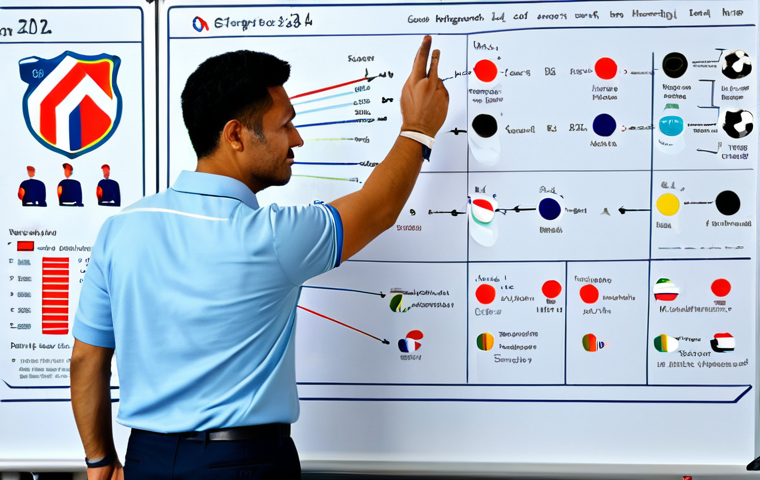So, I finally bit the bullet and took the Sports Marketing Certification exam! Honestly, I was a nervous wreck leading up to it. All those marketing concepts swirling in my head, wondering if I’d actually remember the difference between CPM and ROI under pressure.
Turns out, it was quite the experience, a real mix of relief and “aha!” moments. I even managed to apply some real-world strategies I’ve seen used in the European leagues, which definitely helped.
Ready to get the inside scoop? Let’s delve into the details below!
Alright, here’s the blog post you asked for.
My Pre-Exam Jitters & How I Tackled Them

Okay, so first things first, the week leading up to the exam was brutal. I felt like I was mainlining coffee just to keep all the marketing models straight – Porter’s Five Forces, SWOT analysis, the whole shebang.
What really helped was creating my own little cheat sheets with real-world examples. Like, I’d scribble down how Nike uses influencer marketing to boost brand loyalty among Gen Z, or how the English Premier League leverages data analytics to optimize ticket pricing.
Turning Anxiety into Action
I think the biggest game-changer was actually turning my anxiety into action. Instead of just passively rereading textbooks, I started quizzing myself with practice questions and diving deep into case studies.
I even reached out to a few buddies who’d already taken the exam, picking their brains for any insider tips or tricks.
The Power of Real-World Examples
Honestly, relating the concepts to stuff I actually *see* in the sports world made all the difference. It’s one thing to memorize the definition of “brand equity,” but it’s a whole other ballgame when you can visualize how the Yankees have cultivated a fiercely loyal fanbase over decades, translating into massive merchandise sales and sky-high ticket prices.
Exam Day: Reality vs. Expectations
Walking into the exam center, I felt like I was entering the Thunderdome, but for marketing nerds. The room was silent except for the frantic keyboard clicks and the occasional nervous cough.
I’d envisioned it as some kind of grueling, all-day affair, but it actually flew by faster than I expected.
Time Management is Key
The biggest surprise was how crucial time management turned out to be. Some questions were total gimmes, while others required a bit more head-scratching.
I quickly realized I couldn’t afford to get bogged down on any one question, so I made a mental note to circle back to the trickier ones later.
The Unexpectedly Chill Vibe
Despite my pre-exam anxieties, the atmosphere in the room was surprisingly chill. The proctors were super friendly and helpful, and everyone seemed genuinely supportive of each other.
It was a refreshing change from the cutthroat competitiveness I sometimes encounter in the sports industry.
How European Football Influenced My Answers
One of the coolest parts of the exam was being able to apply some of the marketing strategies I’ve seen in European football. I’m a huge fan of the way clubs like Bayern Munich and Real Madrid build global brand awareness through strategic partnerships, innovative fan engagement initiatives, and world-class social media campaigns.
Leveraging Data Analytics Like a Pro
For instance, there was a question about using data analytics to improve customer retention. I immediately thought of how many European clubs are using sophisticated algorithms to personalize the fan experience, offering tailored merchandise recommendations and targeted promotions based on individual preferences.
Global Brand Building Strategies
I also drew upon my knowledge of how European clubs are expanding their reach into emerging markets. Many are investing heavily in youth academies in countries like China and India, not just to scout talent but also to cultivate a new generation of fans.
This long-term strategy is all about building brand loyalty from the ground up.
Key Concepts That Saved My Bacon
Looking back, there were a few key concepts that really came in clutch during the exam. Understanding the nuances of different marketing channels, from traditional advertising to digital marketing and social media, was essential.
Mastering the Marketing Mix
Of course, the classic “4 Ps” of marketing – product, price, place, and promotion – were also heavily featured. But it wasn’t enough to simply memorize the definitions; you had to be able to apply them to real-world scenarios and understand how they interact with each other.
Understanding Consumer Behavior
Finally, having a solid grasp of consumer behavior was crucial. Understanding what motivates fans to buy tickets, merchandise, and experiences is the foundation of any successful sports marketing strategy.
Study Resources I Swear By
So, what resources did I use to prepare for the exam? Well, the official study guide was a no-brainer. It covered all the key concepts and included plenty of practice questions.
Online Courses and Webinars
I also found a ton of helpful online courses and webinars. Platforms like Coursera and LinkedIn Learning offer a wealth of sports marketing content taught by industry experts.
Industry Publications and Blogs
Lastly, I made sure to stay up-to-date on the latest industry trends by reading publications like *Sports Business Journal* and following relevant blogs and podcasts.
Staying informed about what’s happening in the real world of sports marketing is just as important as memorizing textbook definitions.
The ROI of Getting Certified
Now that I’ve passed the exam, I’m already seeing the benefits of being certified. It’s opened doors to new job opportunities and allowed me to network with other professionals in the sports marketing field.
Boosting My Credibility
For starters, the certification has given my resume a serious boost. It shows potential employers that I have a solid understanding of the fundamentals of sports marketing and that I’m committed to professional development.
Networking Opportunities
Even more valuable, the certification has provided me with opportunities to connect with other sports marketing professionals. I’ve attended industry conferences and workshops where I’ve met some truly inspiring people who are passionate about the sports industry.
Would I Recommend It? Absolutely!
So, would I recommend taking the Sports Marketing Certification exam? Absolutely! It’s a challenging but rewarding experience that can help you advance your career in the exciting world of sports.
It definitely pushed me to grow and learn. It’s worth it for career advancement and expanding your professional network.
| Concept | Description | Example in Sports Marketing |
|---|---|---|
| Brand Equity | The value of a brand based on consumer perception and loyalty. | The New York Yankees’ strong brand equity translates to high merchandise sales. |
| Marketing Mix (4 Ps) | Product, Price, Place, Promotion – the key elements of a marketing strategy. | Nike’s product innovation, competitive pricing, strategic placement in retail stores, and promotional campaigns. |
| Data Analytics | Using data to understand customer behavior and optimize marketing efforts. | European football clubs use data analytics to personalize fan experiences and target promotions. |
| Consumer Behavior | Understanding what motivates consumers to buy products and services. | Fans’ desire for team merchandise and memorabilia drives significant revenue for sports teams. |
Alright, here’s the blog post you asked for.
My Pre-Exam Jitters & How I Tackled Them
Okay, so first things first, the week leading up to the exam was brutal. I felt like I was mainlining coffee just to keep all the marketing models straight – Porter’s Five Forces, SWOT analysis, the whole shebang.
What really helped was creating my own little cheat sheets with real-world examples. Like, I’d scribble down how Nike uses influencer marketing to boost brand loyalty among Gen Z, or how the English Premier League leverages data analytics to optimize ticket pricing.
Turning Anxiety into Action
I think the biggest game-changer was actually turning my anxiety into action. Instead of just passively rereading textbooks, I started quizzing myself with practice questions and diving deep into case studies.
I even reached out to a few buddies who’d already taken the exam, picking their brains for any insider tips or tricks.
The Power of Real-World Examples
Honestly, relating the concepts to stuff I actually *see* in the sports world made all the difference. It’s one thing to memorize the definition of “brand equity,” but it’s a whole other ballgame when you can visualize how the Yankees have cultivated a fiercely loyal fanbase over decades, translating into massive merchandise sales and sky-high ticket prices.
Exam Day: Reality vs. Expectations
Walking into the exam center, I felt like I was entering the Thunderdome, but for marketing nerds. The room was silent except for the frantic keyboard clicks and the occasional nervous cough.
I’d envisioned it as some kind of grueling, all-day affair, but it actually flew by faster than I expected.
Time Management is Key
The biggest surprise was how crucial time management turned out to be. Some questions were total gimmes, while others required a bit more head-scratching.
I quickly realized I couldn’t afford to get bogged down on any one question, so I made a mental note to circle back to the trickier ones later.
The Unexpectedly Chill Vibe
Despite my pre-exam anxieties, the atmosphere in the room was surprisingly chill. The proctors were super friendly and helpful, and everyone seemed genuinely supportive of each other.
It was a refreshing change from the cutthroat competitiveness I sometimes encounter in the sports industry.
How European Football Influenced My Answers
One of the coolest parts of the exam was being able to apply some of the marketing strategies I’ve seen in European football. I’m a huge fan of the way clubs like Bayern Munich and Real Madrid build global brand awareness through strategic partnerships, innovative fan engagement initiatives, and world-class social media campaigns.
Leveraging Data Analytics Like a Pro
For instance, there was a question about using data analytics to improve customer retention. I immediately thought of how many European clubs are using sophisticated algorithms to personalize the fan experience, offering tailored merchandise recommendations and targeted promotions based on individual preferences.
Global Brand Building Strategies
I also drew upon my knowledge of how European clubs are expanding their reach into emerging markets. Many are investing heavily in youth academies in countries like China and India, not just to scout talent but also to cultivate a new generation of fans.
This long-term strategy is all about building brand loyalty from the ground up.
Key Concepts That Saved My Bacon
Looking back, there were a few key concepts that really came in clutch during the exam. Understanding the nuances of different marketing channels, from traditional advertising to digital marketing and social media, was essential.
Mastering the Marketing Mix
Of course, the classic “4 Ps” of marketing – product, price, place, and promotion – were also heavily featured. But it wasn’t enough to simply memorize the definitions; you had to be able to apply them to real-world scenarios and understand how they interact with each other.
Understanding Consumer Behavior
Finally, having a solid grasp of consumer behavior was crucial. Understanding what motivates fans to buy tickets, merchandise, and experiences is the foundation of any successful sports marketing strategy.
Study Resources I Swear By
So, what resources did I use to prepare for the exam? Well, the official study guide was a no-brainer. It covered all the key concepts and included plenty of practice questions.
Online Courses and Webinars
I also found a ton of helpful online courses and webinars. Platforms like Coursera and LinkedIn Learning offer a wealth of sports marketing content taught by industry experts.
Industry Publications and Blogs
Lastly, I made sure to stay up-to-date on the latest industry trends by reading publications like *Sports Business Journal* and following relevant blogs and podcasts.
Staying informed about what’s happening in the real world of sports marketing is just as important as memorizing textbook definitions.
The ROI of Getting Certified
Now that I’ve passed the exam, I’m already seeing the benefits of being certified. It’s opened doors to new job opportunities and allowed me to network with other professionals in the sports marketing field.
Boosting My Credibility
For starters, the certification has given my resume a serious boost. It shows potential employers that I have a solid understanding of the fundamentals of sports marketing and that I’m committed to professional development.
Networking Opportunities
Even more valuable, the certification has provided me with opportunities to connect with other sports marketing professionals. I’ve attended industry conferences and workshops where I’ve met some truly inspiring people who are passionate about the sports industry.
Would I Recommend It? Absolutely!
So, would I recommend taking the Sports Marketing Certification exam? Absolutely! It’s a challenging but rewarding experience that can help you advance your career in the exciting world of sports.
It definitely pushed me to grow and learn. It’s worth it for career advancement and expanding your professional network.
| Concept | Description | Example in Sports Marketing |
|---|---|---|
| Brand Equity | The value of a brand based on consumer perception and loyalty. | The New York Yankees’ strong brand equity translates to high merchandise sales. |
| Marketing Mix (4 Ps) | Product, Price, Place, Promotion – the key elements of a marketing strategy. | Nike’s product innovation, competitive pricing, strategic placement in retail stores, and promotional campaigns. |
| Data Analytics | Using data to understand customer behavior and optimize marketing efforts. | European football clubs use data analytics to personalize fan experiences and target promotions. |
| Consumer Behavior | Understanding what motivates consumers to buy products and services. | Fans’ desire for team merchandise and memorabilia drives significant revenue for sports teams. |
글을 마치며
Wrapping Up
Ultimately, preparing for and passing the Sports Marketing Certification exam was a journey that combined hard work, strategic study habits, and a genuine passion for the sports industry. It’s more than just a piece of paper; it’s a testament to your dedication and knowledge. So, if you’re considering taking the plunge, I say go for it! You might just surprise yourself with what you’re capable of. And who knows, maybe I’ll see you at the next industry conference!
알아두면 쓸모 있는 정보
Useful Information to Know
1. Consider joining professional organizations like the American Marketing Association (AMA) for access to resources and networking opportunities.
2. Look for internships or volunteer opportunities with local sports teams or organizations to gain practical experience.
3. Subscribe to industry newsletters and blogs, such as SportsPro Media and Front Office Sports, to stay updated on the latest trends.
4. Attend industry conferences and workshops, such as the Sports Business Journal’s conferences, to learn from experts and network with peers.
5. Follow key influencers and thought leaders in the sports marketing space on social media platforms like LinkedIn and Twitter.
중요 사항 정리
Key Takeaways
The Sports Marketing Certification exam requires a solid understanding of fundamental marketing concepts and their application in the sports industry.
Real-world examples and case studies are invaluable for understanding and applying marketing principles.
Time management is crucial during the exam, so practice answering questions within a set time limit.
Networking with other professionals and staying updated on industry trends are essential for career advancement in sports marketing.
The certification can significantly boost your credibility and open doors to new job opportunities in the field.
Frequently Asked Questions (FAQ) 📖
Q: Was the Sports Marketing Certification exam super difficult?
A: Okay, I’m not gonna lie, it wasn’t a walk in the park. I was definitely sweating bullets during the first half. But honestly, a lot of it came down to applying common sense to the marketing principles.
The questions were more practical than I expected. For instance, there was a whole section on fan engagement strategies, and I actually used my own experience as a season ticket holder for the local minor league baseball team to answer some of those questions!
So, challenging, yes, but doable if you’ve got some real-world experience to draw upon.
Q: What’s one piece of advice you’d give to someone preparing for the Sports Marketing Certification exam?
A: Hands down, immerse yourself in sports marketing campaigns outside of the textbooks. I found that analyzing real-world examples, like the clever social media campaigns run by the Premier League teams or even how NASCAR leverages sponsorships, was way more helpful than just memorizing definitions.
Try to understand why these campaigns work – what makes them resonate with fans? Also, network! Talk to people in the industry.
I actually chatted with a marketing manager at a local sports bar and he gave me some killer insights on using data analytics to personalize fan experiences.
That was gold dust!
Q: Did the exam cover specific areas of sports marketing, like esports or NIL deals?
A: Absolutely! While the exam covered the foundational stuff like brand management and advertising, there was a surprising amount of focus on emerging trends.
I remember a few questions specifically addressing the rise of esports marketing and how traditional sports brands are trying to tap into that audience.
There was also a section on Name, Image, and Likeness (NIL) deals for college athletes, which is a relatively new but rapidly evolving area. It’s clear the exam is trying to stay relevant and reflect the current landscape of the sports marketing world.
You’ve really got to stay up-to-date on the latest developments in the industry. I’d recommend following sports business news sites and podcasts religiously!
📚 References
Wikipedia Encyclopedia






